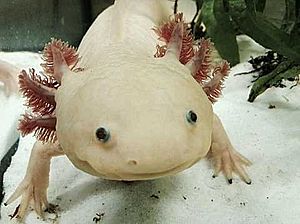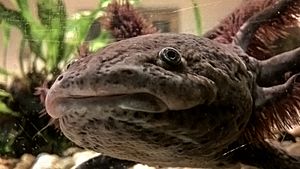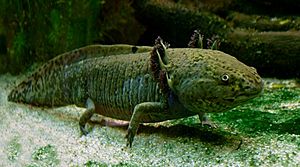Axolotl facts for kids
Quick facts for kids Axolotl |
|
|---|---|
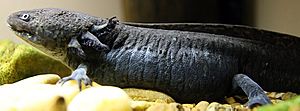 |
|
| Conservation status | |
| Scientific classification | |
| Genus: |
Ambystoma
|
| Species: |
mexicanum
|
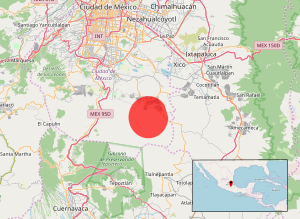 |
|
| Its distribution is marked in red. | |
| Synonyms | |
|
|
The axolotl (say "AX-oh-lot-ul") is a special type of salamander. It's closely related to the tiger salamander. Axolotls are unique among amphibians because they stay in their "baby" form even when they grow up. This means they don't go through metamorphosis like most amphibians. They keep their legs and feathery gills and live their whole lives in the water.
These amazing creatures were first found in lakes near Mexico City. Sadly, many of these lakes were drained by early settlers, which destroyed much of the axolotl's natural home. Because of this, wild axolotls are now listed as critically endangered.
Scientists study axolotls that live in tanks because they have an incredible ability to regrow lost body parts. They can even regrow limbs, gills, and parts of their eyes and brains!
Contents
What is an Axolotl?
Unlike most amphibians, an axolotl does not change much as it gets older. Most amphibians lose their gills, grow lungs, and move onto land. But axolotls keep their gills, which look like delicate feathers, and they stay in the water. They do grow lungs too, which they use if they go to the water's surface.
Size and Appearance
When they are about 18 to 27 months old, adult axolotls can be from 15 to 45 centimeters (6 to 18 inches) long. They have wide heads and eyes without eyelids. Their mouths are shaped in a way that makes them look like they are always smiling! Male axolotls are wider at the back, while females are wider in the middle because they carry eggs.
Axolotls have four genes that control their color. They can be many shades, from pinkish to brownish-green. Many people who keep them as pets like the white or pink ones best. Axolotls can also change their color a little bit to help them blend in with their surroundings.
Where Axolotls Live
In the wild, axolotls are only found in one place: Lake Xochimilco, which is just outside Mexico City. The water in Lake Xochimilco is usually cool, staying around 20°C (68°F). In winter, it can get colder, sometimes as low as 6-7°C (43-45°F).
How Axolotls Reproduce
Axolotls can have babies up to three times a year. Their mating ritual looks like a special dance. After this, the female lays between 100 and 300 eggs. These eggs hatch in about 10 to 14 days, and the baby axolotls are then on their own.
What Axolotls Eat and Who Eats Them
In the wild, axolotls eat almost anything they can catch. This includes small creatures like mollusks, worms, fish, and even insects that land on the water. If you have an axolotl as a pet, they can eat things like trout and salmon pellets, frozen or live bloodworms, earthworms, waxworms, and small feeder fish.
Axolotls don't have many enemies. The main animals that hunt and eat axolotls are Storks, herons, carp, and tilapia.
Axolotl Conservation Status
The number of wild axolotls is very low, with fewer than 1,000 left. This is why they are considered critically endangered.
Threats to Axolotls
Axolotls used to live in many lakes and wetlands in Mexico's Central Valley. But as Mexico City grew, their natural home shrank. Now, they are only found in Lake Xochimilco. This lake is not very big; it's more like a system of small channels, lakes, and temporary wet areas.
The water in Lake Xochimilco is not very clean. This is because of farming and fish farming in the area, and also because only partly treated wastewater flows into the lake. Tests show the water doesn't have much oxygen, which isn't good for axolotls. Also, pesticides from nearby farms wash into the lake. These chemicals can harm baby axolotls, causing them to die or develop problems.
Another big problem for wild axolotls is the introduction of fish like the Nile tilapia and common carp. These fish are not native to the lake. They eat axolotl eggs and young, and they compete with axolotls for food. The presence of these fish also makes axolotls less active, which means they hunt less and have fewer chances to mate.
Conservation Efforts
Scientists are working hard to save the axolotl. One idea is to move axolotls raised in captivity to new, clean habitats, or even back into Lake Xochimilco. A lab at the National Autonomous University of Mexico (UNAM) has raised over 100 axolotls. They are planning to create a special wetland inside the university to help a healthy group of axolotls live there. Studies show that axolotls raised in a more natural setting can learn to hunt and survive in the wild. This gives hope that these captive-bred axolotls can help bring the wild population back.
Why Scientists Study Axolotls
Scientists are very interested in studying axolotls. They are easy to breed, and their embryos (developing babies) are large, which makes it easy for scientists to watch them grow. Axolotls also have amazing abilities to regrow body parts and go through metamorphosis in a unique way.
Amazing Regeneration
When an axolotl gets hurt, it doesn't heal with a scar. Instead, it can regrow a whole lost limb in just a few months! Sometimes, they can even regrow parts of their central nervous system (like parts of their brain and spinal cord), and tissues in their eyes and heart. They have even been known to grow an extra limb when they are repairing a damaged one.
Unique Metamorphosis
Axolotls don't have enough of a certain hormone to go through a full metamorphosis. This is why they keep their gills and stay in the water their whole lives. Even though they use their gills to breathe underwater, they also develop lungs and can use them if they come to the surface. Sometimes, people try to make an axolotl go through full metamorphosis by giving it an injection, but this can be harmful to the animal.
Keeping Axolotls as Pets
The axolotl is a popular exotic pet. If you have an axolotl, you need to be a responsible pet owner. You should never put Chlorine (like what's in tap water) directly into their tank. Special salts, like Holtfreter's solution, are often added to the water to help prevent infections. The water in the tank should be kept cool, around 16°C to 18°C (61°F to 64°F). A single axolotl usually needs a tank that holds about 150 liters (40 gallons). Axolotls spend most of their time at the bottom of their tank.
The material at the bottom of the tank is important. Axolotls sometimes eat their bedding material, and if it's too small, it can get stuck in their intestines and make them sick. Pet owners should use items that are at least 3 centimeters (about 1.2 inches) wide, or roughly the size of the axolotl's head, for the bottom of the tank.
Cultural Importance
The axolotl is named after Xolotl, an Aztec deity (god). Legend says Xolotl changed himself into an axolotl to avoid being sacrificed. Axolotls are still an important part of Mexican culture today and can be seen in cartoons and murals.
In 2020, it was announced that the axolotl would be featured on the new design for Mexico's 50-peso banknote, along with images of maize (corn) and chinampas (floating gardens).
Interesting Facts About the Axolotl
- The axolotl is sometimes called the "Mexican walking fish."
- Legend says the axolotl is the Aztec god of fire and lightning, Xolotl, who disguised himself as a salamander to avoid being sacrificed.
- Axolotls look like babies for their entire lives. They do not go through a full metamorphosis.
- They can swim very fast, up to 15 km/h (10 mph).
- An axolotl can live for up to 15 years.
- Axolotls have the ability to sense electric fields.
- They usually live alone and only interact with other axolotls to mate.
- Axolotls can accept organ transplants and quickly get the organs working again.
See also
 In Spanish: Ajolote para niños
In Spanish: Ajolote para niños
- Mudpuppies
- Olm
- Texas salamander
- Texas blind salamander
- Lake Patzcuaro salamander
- Barred tiger salamander
- Amphibious fish
- Handfish
- Regenerative biomedicine



